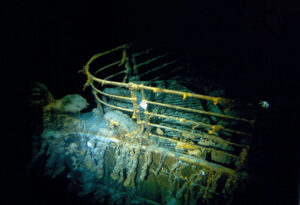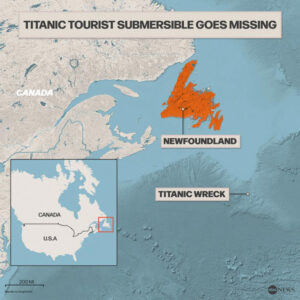JUNE 20, 2023

FILE – This handout image taken during the historical 1986 dive, courtesy of WHOI (Woods Hole Oceanographic Institution) and released Feb. 15, 2023 shows the Titanic bow. – Woods Hole Oceanographic Institute/AFP via Getty Images, FILE
A submersible carrying five people has gone missing while on a tour of the underwater wreckage of the Titanic off the coast of Newfoundland, Canada.
The deep-sea vessel, operated by OceanGate Expeditions, lost contact about an hour and 45 minutes after submerging on Sunday morning with a 96-hour oxygen supply. The United States Coast Guard, in coordination with the Canadian Coast Guard and the Canadian Armed Forces, immediately launched a search and rescue operation for the 21-foot sealed craft, named Titan.

Titanic tourist submersible goes missing.
Latest Developments
‘It’s a race against time’
Per Wimmer, an explorer and global financier, told ABC News he was “shocked” and “horrified” to hear of the missing submersible.
“It felt very personal. … I’ve been wanting to go down to the Titanic for more than a decade,” Wimmer said.
He estimated that there’s been between 150 and 200 missions to the Titanic.
There “are very, very few submersibles in the whole world that can go down to the depth of Titanic, which sits at 3,800 meters, or about 12,000 feet,” Wimmer said. “It’s very deep — most submersibles can go down to about 1,000 meters.”
“It’s a race against time, because there’s only 96 hours of oxygen on board. And after that, if you haven’t reached the surface, you starve of oxygen,” he said.
“Our best hope at the moment is that the safety mechanism will be activated,” he said. “It is supposed to be able to float to the surface, little by little, and then they can open the hatch and hopefully get out again. That is the only hope we have, because you do not have enough time to get another submersible that can go that deep.”
-ABC News’ Dom Proto
What to know about the 5 people aboard the missing sub
Renowned explorers and a father-son duo were among the five people aboard a submersible that disappeared in the Atlantic Ocean on Sunday while touring the Titanic wreckage, ABC News has learned.
ABC News has confirmed and identified four of those on aboard as Hamish Harding, a British businessman, pilot and space tourist; Paul-Henri Nargeolet, a French diver and Titanic expert; Shahzada Dawood, a Pakistani businessman, and his son Suleman Dawood.
-ABC News’ Victoria Beale, Miles Cohen, Larissa Demkiw and Anna Rabemanantsoa
US Coast Guard commander talks search for missing sub
The United States Coast Guard commander leading the search for a missing submersible off the coast of Newfoundland, Canada, said Tuesday morning that crews in multiple aircraft have flown over an area of the Atlantic Ocean “roughly about the size of Connecticut” while “looking for any signs of surfacing.”
“As we continue on with the search, we’re expanding our capabilities to be able to search under the water as well,” Rear Adm. John Mauger, commander of the First Coast Guard District, told ABC News’ Robin Roberts during an interview on “Good Morning America.”
A commercial vessel with remotely operated vehicles is now on scene that will allow rescuers to search underwater, according to Mauger.
“This is a complex case,” he added. “The Coast Guard doesn’t have all the resources to be able to affect this kind of rescue, although this is an area that’s within our search zone.”
In many cases, Mauger said, the Coast Guard’s role is to coordinate all of the assets and technical expertise that can be used in a search, in addition to operating aircraft or ships when necessary.
“In this particular case, we’ve established a unified command with the United States Navy, with the Canadian Armed Forces, with the Canadian Coast Guard and with the private operator OceanGate Expeditions to make sure that we understand what’s needed and deploy all available equipment to the scene that could be used to locate this submersible, whether it’s on the surface or down beneath the surface,” he said.
Crews have been working “around the clock” to locate the deep-sea vessel since it lost contact with its operator on Sunday morning, according to Mauger.
In the last 24 hours, a Canadian aircraft has been dropping sonar buoys into the water that can pick up sound the submersible may be emitting. Vessels that have the capability to listen with their own sonar equipment are also on scene, according to Mauger.
“If they are making sound, that’s certainly one of the ways that we’re going to use to locate them,” he said.
Missing sub believed to be deeper than NATO rescue capability
A tourist submersible that disappeared in the Atlantic Ocean on Sunday is believed to be at depths that greatly exceed the capabilities of the NATO Submarine Rescue System (NSRS), according to a spokesperson for the United Kingdom’s Ministry of Defense.
“As the host nation for NATO’s multinational submarine rescue capability, we continue to monitor the incident in the North Atlantic and will guide and assist in any response activity as appropriate,” the spokesperson told ABC News in a statement on Tuesday.
The U.K. has not been approached to offer assistance in the ongoing search for the deep-sea vessel off the coast of Newfoundland, Canada, according to the spokesperson.
Initial reports indicate that the depths of water involved greatly exceed that which the NSRS team can safely operate — 610 meters for the NSRS submersible and 1,000 meters for the NSRS remotely operated vehicle, according to the spokesperson.
The NSRS is based at the home of the U.K. Royal Navy Submarine Service in HM Naval Base Clyde, the U.K. Royal Navy’s headquarters in Scotland. Introduced in 2006, the tri-national capability team can respond to a stricken submarine in rescuable water which is capable of mating with the NSRS submarine rescue vehicle, according to the spokesperson.
-ABC News’ Emma Ogao
Former Navy sub captain on rescue options
Rescuers racing against the clock to save the five people trapped in a tourist submersible nearly two miles deep in the Atlantic Ocean are facing major obstacles that could make saving the people onboard extremely difficult, according to a former U.S. Navy submarine commander.
Retired Capt. David Marquet told ABC News on Monday that this type of rescue operation is complicated because there aren’t nearby U.S. or Canadian underwater vessels that can go as deep as the Titanic wreckage, which sits 13,400 feet below the ocean’s surface. Also, the ocean is pitch black at that depth.
“The odds are against them,” Marquet said. “There’s a ship in Boston that has this ability to either lower cable and connect to it or have a claw. It’s still a thousand miles away.”
Even if a vessel was able to locate the submersible and lower a cable, it’s extremely difficult to safely navigate the waters and attach it, according to Marquet.
“You’ve got to get it exactly right,” he told ABC News. “It’s sort of like … getting one of those toys out of those arcade machines. In general, you miss.”
Rescuers do have one advantage, Marquet said, as weather conditions off the coast of Newfoundland are not rough and will not disturb any boat or vessel there.
Marquet added that if the five people aboard are still alive, they would be asked to sleep to conserve their oxygen.
“We would put the vast majority of the crew to sleep because that’s when you’re using the least amount of oxygen and you’re expelling the least amount of carbon dioxide,” he said.
-ABC News’ Sam Sweeney and Ivan Pereira
What to know about the missing sub
A submersible on a tour of the Titanic wreckage was reported overdue by its operator OceanGate Expeditions on Sunday, prompting the United States Coast Guard to launch a search and rescue effort for the 22-foot, 23,000-pound vessel.
Designed with life support to sustain five crew members for 96 hours, the submersible would need to be rescued in three days to save its five passengers, according to the Coast Guard.
Stockton Rush founded Washington-based OceanGate in 2009 to make deep-sea exploration more accessible to scientists and tourists. Fourteen years, more than 200 dives and three submersible designs later, the company now finds itself in a desperate search to recover the submersible carrying five people aboard that’s gone missing off the coast of Newfoundland, Canada.
OceanGate confirmed Monday it had lost contact with a submersible, saying in a statement: “We are exploring and mobilizing all options to bring the crew back safely. Our entire focus is on the crewmembers in the submersible and their families. We are working toward the safe return of the crewmembers.”
Courtesy/Source: ABC News































































































